Hōryū-ji
| Hōryū-ji 法隆寺 | |
|---|---|
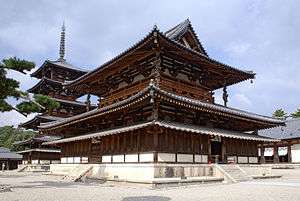 | |
| Basic information | |
| Location | 1-1 Hōryū-ji Sannai, Ikaruga-chō, Ikoma-gun, Nara Prefecture |
| Affiliation | Shōtoku |
| Deity | Shaka Nyorai (Śākyamuni) |
| Country | Japan |
| Website | http://www.horyuji.or.jp/ |
| Architectural description | |
| Founder | Empress Suiko, Prince Shōtoku |
| Completed | 607 |
Hōryū-ji (法隆寺, lit. Temple of the Flourishing Law) is a Buddhist temple that was once one of the powerful Seven Great Temples, in Ikaruga, Nara Prefecture, Japan. Its full name is Hōryū Gakumonji (法隆学問寺), or Learning Temple of the Flourishing Law, the complex serving as both a seminary and monastery.
The temple's pagoda is widely acknowledged to be one of the oldest wooden buildings existing in the world, underscoring Hōryū-ji's place as one of the most celebrated temples in Japan.[1][2] In 1993, Hōryū-ji was inscribed together with Hokki-ji as a UNESCO World Heritage Site under the name Buddhist Monuments in the Hōryū-ji Area. The Japanese government lists several of its structures, sculptures and artifacts as National Treasures. A study of its shinbashira, the central wooden column almost suspended inside the Tō in 2001 led to a conclusion about the structure being older than previously thought by a century.
History
The temple was originally commissioned by Prince Shōtoku; at the time it was called Ikaruga-dera (斑鳩寺), a name that is still sometimes used. This first temple is believed to have been completed by 607. Hōryū-ji was dedicated to Yakushi Nyorai, the Buddha of healing and in honor of the prince's father.[2] Excavations done in 1939 confirmed that Prince Shotoku's palace, the Ikaruga-no-miya (斑鳩宮), occupied the eastern part of the current temple complex, where the Tō-in (東院) sits today.[3] Also discovered were the ruins of a temple complex which was southwest of the prince's palace and not completely within the present temple complex.[3] The original temple, named by modern historians and archaeologists Wakakusa-garan (若草伽藍), was lost, probably burned to the ground after being hit by lightning in 670. The temple was reconstructed but slightly reoriented in a northwest position, which is believed to have been completed by around 711.[4] The temple was repaired and reassembled in the early twelfth century, in 1374, and 1603.[5]
In 1950 the maintainers of the temple broke away from the Hossō sect. The owners currently call the temple the headquarters of the "Shōtoku" sect.
Reconstruction controversy
After the long controversy ignited by architecture historian Sekino in 1905, the majority consensus view as of 2006 is that the current precinct is a reconstruction. The excavations in 1939 that uncovered the older temple site including architectural remains of a Kondō and a pagoda, are accepted as conclusive proof. The original complex, Wakakusa-garan, probably burned down, but there is still a debate as to whether a fire actually occurred in 670, as recorded in the Nihon Shoki, or whether there was another reason.[6]
Architecture
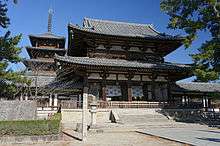
The present complex
The current temple is made up of two areas, the Sai-in (西院) in the west and the Tō-in (東院) in the east. The western part of the temple contains the Kondō (金堂, sanctuary Hall) and the temple's five-story pagoda. The Tō-in area holds the octagonal Yumedono Hall (夢殿, Hall of Dreams) and sits 122 meters east of the Sai-in area. The complex also contains monk's quarters, lecture halls, libraries, and dining halls.
Characteristics

The reconstructed buildings embrace significant cultural influences from the Three Kingdoms of Korea, particularly those of Baekje, as well as from Eastern Han to Northern Wei of China.[7] The Chinese influence comes via Baekje, since Baekje had permanent trading relation with China.
With its origin dating back to early 7th century, the reconstruction has allowed Hōryū-ji to absorb and feature a unique fusion of early Asuka period style elements, added with some distinct ones only seen in Hōryū-ji.
There are many features that suggest the current precinct of Hōryu-ji is entirely not related to the Asuka period style (a style that seems nonexistent).[8]
Pagoda

The five-storey pagoda, located in Sai-in area, stands at 32.45 meters in height (122 feet) and is approximately 20X20 in width and is one of the oldest wooden buildings in the world. The wood used in the center pillar of the pagoda is estimated through a dendrochronological analysis to have been felled in 594.[4] The central pillar rests three meters below the surface of the massive foundation stone, stretching into the ground. At its base is enshrined what is believed to be a fragment of one of Buddha's bones. Around it, four sculpted scenes from the life of the Buddha face north, east, south and west.[9] Although the pagoda is five-storied, it does not allow one to climb up inside, but it is rather designed to inspire people with its external view.[10]
Kondō
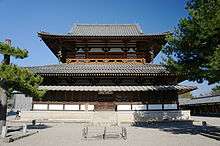
The kondō, located side-by-side to the Pagoda in Sai-in, is another one of the oldest wood buildings extant in the world. The hall measures 18.5 meters by 15.2 meters.[8] The hall is two storied, with roofs curved in the corners but only the first story has a double roof (裳階 mokoshi). This was added later in the Nara period with extra posts to hold up the original first roof because it extended more than four meters past the building.[11]
Due to a fire incident that broke out on January 26, 1949, severe damage was caused to the building, mainly its first floor, and the murals. As a result of the restoration (completed in 1954), it is estimated that about fifteen to twenty percent of the original seventh century Kondo materials is left in the current building, while the charred members were carefully removed and rebuilt to a separate fireproof warehouse for future research.[10][12][13]
Through a recent dendrochronological analysis carried out using the materials preserved during the restorations done in the 1950s, it has turned out that some of them were felled prior to 670, suggesting a possibility that the current kondō was already under construction when "the fire in 670", as recorded in the Nihon Shoki, burned the former Wakakusa-garan down.[14]
The hall holds the famous Shaka Triad, together with a bronze Yakushi and Amida Nyorai statues, and other national treasures. The wall paintings shown today in the Kondō are a reproduction from 1967.
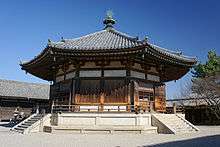
Yumedono (Hall of Dreams)
Yumedono is one of the main constructions in the Tō-in area, built on the ground which was once Prince Shōtoku's private palace, Ikaruga no miya. The present incarnation of this hall was built in 739 to assuage the Prince's spirit. The hall acquired its present-day common name in the Heian period, after a legend that says a Buddha arrived as Prince Shōtoku and meditated in a hall that existed here. The hall also contains the famous Yumedono Kannon (also Kuse-, or Guze Kannon); which is only displayed at certain times of the year.[15]
Treasures
The treasures of the temple are considered to be a time capsule of Buddhist art from the sixth and seventh century. Much of the frescoes, statues, and other pieces of art within the temple, as well as the architecture of the temple's buildings themselves show the strong cultural influence from China, Korea and India and demonstrated the international connection of the countries of East Asia.[16][17] It is speculated that all these influences came from Baekje, since Baekje sent out court authorities to look for Japan's local administration.
The Tokyo National Museum holds over 300 objects which were donated to the Imperial Household by Hōryu-ji in 1878. Some of these items are on public display, and all are available for study as part of the museum's digital collection.[18]
Kudara Kannon
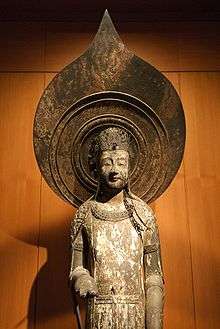
Made by a Baekje craftsman and then sent to Japan as a present, the Kudara Kannon is a statue of Guanyin and made of gilded camphor wood. It is 210 centimeters in height[19] and shoulders the halo. The statue is unique in Japanese art,[20] and regarded as one of the most important works of ancient Japan. It is housed in a specially created room in the temple's recently constructed treasure hall.
The statue is very thin which also creates the illusion of height. The word "Kudara" in Japanese stands for the kingdom of Baekje from the Three Kingdoms Period of Korea. A text from 1698 describes the statue as being rediscovered. Its name was given in the Meiji period because the legend that this statue came to Japan from the Korean Peninsula, and prior to this the statue was called Kokuzo Bosatsu.[21] Many art critics believe it to be a Korean creation, although uncredible source suggests that the statue was carved in Japan.[19] Japanese art historians believe that the statue was carved in late 7th century and influenced from the Southern dynasties styles.
Murals
The murals of the kondō comprise fifty walls; four larger walls, eight mid-sized walls and thirty-eight small wall areas inside the building. The original murals were removed after the fire incident in 1949 and are kept in a non-public treasure house. Twenty small wall paintings, unscathed from the 1949 fire, are in their original places while reproductions replaced the parts that were removed due to damage.
It is generally believed that the paintings on the large walls represent the Pure Land (浄土 jōdo) with Shaka, Amida, Miroku and Yakushi Nyorai Buddhas. Some of the artistic choices, including the way the robes are modeled, are similar to murals found in Ajanta Caves (India) or Dunhuang (China.) Also observed are Tang and Indian flavors of the Bosatsu and Kannon drawn on the sides of the Amida.
Judging from the early Tang influences, the present day consensus on the time of creation of the paintings is end of 7th century. Thus ruling out the possibilities of authorship by those early 7th century figures who were once believed to be the creator, e.g. Tori or Donchō, there is no clear or accepted author of this work.[11][22][23]
Shaka Triad
Tori Busshi is credited with the casting of this massive Buddhist statue. It is a triad and so Sakyamuni, the center Buddha, is attended by two other figures, Bhaisajyaguru to its right and Amitābha to its left. The statues are dated to 623 and the style originates in Northern Wei art.[19][24] The style of the statue is also known as Tori style and is characterized by the two-dimensionality of the figure and the repetitive pattern-like depictions of the cloth the triad sits upon.[19] At each corner of the triad stand four wooden Shitennō statues from the end of the Asuka period. They are the oldest examples of Shitennō statues in Japan.[25]
Tamamushi Shrine
The Tamamushi Shrine is a common example of painting that derived from Baekje and provides important evidence for the Korean peninsula's and the Chinese mainland's strong cultural transfer to the Japanese islands.[26][27] The shrine is named for the many wings of the tamamushi beetle that once adorned it but have since deteriorated.[26][28] The paintings that cover building and dais are of Jataka tales, bodhisattvas, the Four Heavenly Kings, and other buddhist iconography. The front panels of the building show the Four Guardian Kings clad in armor with long flowing scarves. On the side doors are bodhisattvas holding lotus blossoms and forming a mudra. On the back is represented a sacred landscape with heights topped with pagodas. The dais shows on its front relics, seated monks making offerings, and apsara. On the back is depicted Mount Sumeru. The right side shows a scene from the Nirvana Sutra, where the Buddha offers his life in return for more of the sacred teachings, before being caught in his plummet by Indra. On the left panel of the dais is a scene from the Golden Light Sutra of a bodhisattva removing his upper garments before casting himself from a cliff to feed a hungry tigress and her cubs.[26]
Yakushi Nyorai
The statue of Yakushi of the original temple was saved during the fire of 670.[29] While the temple was being rebuilt the Shaka Triad was commissioned or had been already cast.
Yumedono (Guze) Kannon
This Kannon is a statue that supposedly is the representation of Prince Shotoku. It is approximate six feet and one inch and some sources believe that Shotoku was that height. It is 197 centimeters in height.[19] The kannon is made of gilded wood. It is suggested that the statue was made to assuage the dead prince's spirit based on the fact that the halo was attached to the statue by a nail driven through the head. The statue bears a close resemblance to extant portraiture of the prince. The Kannon retains most of its gilt. It is in superb condition because it was kept in the Dream Hall and wrapped in five hundred meters of cloth and never viewed in sunlight. The statue was held to be sacred and was never seen until it was unwrapped at the demand of Ernest Fenollosa, who was charged by the Japanese government to catalogue the art of the state and later became a curator at the Boston Museum of Fine Art.[20] Art historians suggest that this figure is based on the Tori Busshi style.[19]
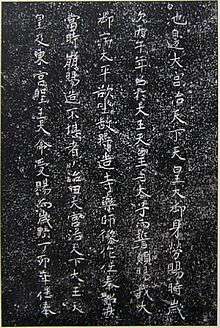
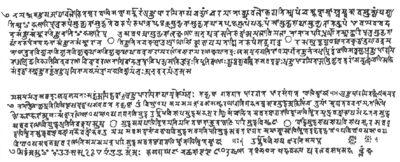
Serving the needs of architectural research
The Nihon Shoki records the arrival of a carpenter and a buddhist sculptor in 577, along with the monks, from Baekje to Japan, which is an underlying fact of importing the mainland expertise through this Korean kingdom with whom Japan enjoyed close relations, in order to build temples locally. These experts are recorded to have stationed in Naniwa, or present-day Osaka, where the Shitennō-ji was built.[30]
There is no record, on the other hand, as to who exactly were the people that have engaged in the constructing of Hōryū-ji, although the Nihon Shoki records the existence of 46 temples in 624.[31] The bracket work of Hōryū-ji resembles that of the partial remainder of a miniature Baekje gilt bronze pagoda.[32]
Images
-

Kudarakan'nondō
-

Kondō and pagoda
-

Bronze lantern
-

Yumedono roof decoration
-

Guardian statue
-
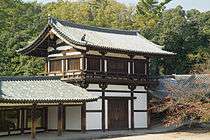
-

Reidō and the Cloister of Toin
-

-
Onigawara roof tile
-
Dragon ornaments on the roof
-

The Horyu-ji complex
-

Panoramic view
See also
- Hokki-ji
- Masaoka Shiki
- Nanto Shichi Daiji, Seven Great Temples of Nanto.
- Buddhist temples in Japan
- Japanese architecture
- Buddhist Monuments in the Hōryū-ji Area
- List of National Treasures of Japan (crafts-others)
- List of National Treasures of Japan (sculptures)
- List of National Treasures of Japan (temples)
- For an explanation of terms concerning Japanese Buddhism, Japanese Buddhist art, and Japanese Buddhist temple architecture, see the Glossary of Japanese Buddhism.
- Tourism in Japan
References
- ↑ "Buddhist Monuments in the Horyu-ji Area, UNESCO World Heritage". Retrieved 2007-04-02.
- 1 2 June Kinoshita; Nicholas Palevsky (1998). Gateway to Japan, "A Japanese Prince and his temple". Kodansha International. ISBN 9784770020185. Retrieved 2007-04-02.
- 1 2 John Whitney Hall (1988). The Cambridge history of Japan "The Asuka Enlightenment" p.175. Cambridge University. ISBN 9780521223522. Retrieved 2007-04-03.
- 1 2 Web Japan, sponsored by the Ministry of Foreign Affairs, Japan. "One hundred years older than supposed?: World Heritage Pagoda". Retrieved 2007-04-04.
- ↑ Marstein, Nils; Knut Einar Larsen (2000). Conservation of Historic Timber Structures: an ecological approach 0750634340&id=wVk7s0W8IT8C&pg=PA22&lpg=PA20&dq=horyu+ji&sig=9BaILwCHspQcsoUcYN5Cf8CYE9E. Elsevier. p. 22. ISBN 0-7506-3434-0. External link in
|title=(help) - ↑ Ryōshin Takada 高田良信 (2007). sekai bunka isan Horyuji o kataru 世界文化遺産法隆寺を語る (Horyuji, a World Heritage described). Yanagihara Shuppan 柳原出版. pp. 34–37.
- ↑ http://www.orientalarchitecture.com/nara/horyujiindex.htm
- 1 2 Banister Fletcher,, Dan (EDT) Cruickshank (1996). Banister Fletcher's A History of Architecture, p731. Architectural Press. ISBN 9780750622677. Retrieved 2007-04-03.
- ↑ Ryōshin Takada 高田良信 (2007). sekai bunka isan Horyuji o kataru 世界文化遺産法隆寺を語る (Horyuji, a World Heritage described). Yanagihara Shuppan 柳原出版. pp. 185–190. During the reconstruction of the pagoda in the 1950s, the reliquary was shortly removed from the hollow for restoration, then placed back.
- 1 2 Seiroku Noma (2003). The Arts of Japan, p40. John Rosenfeld (Trans.). Kodansha International. ISBN 9784770029775. Retrieved 2007-04-03.
- 1 2 Crouch, Dora P; Johnson, June G (2001). ISBN 0195088913 p20. ISBN 9780195088915. Not retrievable on the web as of April 2nd, 2007
- ↑ Nils Marstein; Knut Einar Larsen. Conservation of Historic Timber Structures: an ecological approach p21. Elsevier. ISBN 9780750634342. Retrieved 2007-04-03.
- ↑ Niels Gutschow; Siegfried RCT Enders (1998). Hozon: architectural and urban conservation in Japan, p48. Edition Axel Menges. Retrieved 2007-04-03.
- ↑ "Find rekindles debate over Horyuji Temple". The Japan Times Ltd. 2004-07-20. Retrieved 2007-04-04.
- ↑ Usually in spring and autumn, for about a month period each.
- ↑ "The Archeology of Korea and Cultural Features". Retrieved 2007-04-02.
- ↑ John Whitney Hall (1988). The Cambridge history of Japan "The Asuka Enlightenment" p.176. Cambridge University. ISBN 9780521223522. Retrieved 2007-04-03.
- ↑ "東京国立博物館 - 展示 法隆寺宝物館". Tnm.go.jp. Retrieved 2012-08-15.
- 1 2 3 4 5 6 Tsuneko S. Sadao; Stephanie Wada (2003). Discovering the Arts of Japan: A Historical Overview, p42-44. Kodansha International. ISBN 9784770029393. Retrieved 2007-04-03.
- 1 2 Kinoshita, June; Nicholas Palevsky (1998). Gateway to Japan. Kodansha. pp. 587–588. ISBN 4-7700-2018-X.
- ↑ 法隆寺諸堂仏躰数量記
- ↑ James Huntley Grayson (2002). Korea: A Religious History "Early Korea" p36. Routledge. ISBN 9780700716050. Retrieved 2007-04-03.
- ↑ Takada, Ryoshin (1998). Horyu-ji no nazo 法隆寺の謎 Mysteries of Horyu-ji. Shogakukan. pp. 131–132. ISBN 4-09-387265-1.
- ↑ Chatfield Pier, Garrett (2005). Temple Treasures of Japan 141796569X&id=s_S4NqCg4iMC&pg=PA15&lpg=PA15&vq=korean&dq=korean+sculpture&sig=KQapTXiFzRxAco28wt9Y9QjVc_U. Kessinger Publishing. p. 15. ISBN 1-4179-6569-X. External link in
|title=(help) - ↑ Hōryūji (tourist brochure). Kyoto, Japan: Benrido Co., Ltd. 2007. pp. 11–12.
- 1 2 3 Mizuno Seiichi (1974). Asuka Buddhist Art: Horyuji. Weatherhill. pp. 40–52.
- ↑ "Tamamushi no zushi". Japanese Architecture and Art Net Users System. Retrieved 9 March 2012.
- ↑ "Sentaibutsu". Japanese Architecture and Art Net Users System. Retrieved 9 March 2012.
- ↑ Robert Treat Paine (1981). The Art and Architecture of Japan , p300. Yale University Press. ISBN 0300053339. Retrieved 2007-04-03.
- ↑ "Asian Historical Architecture, Horyuji Temple". Retrieved 2007-04-02.
|first1=missing|last1=in Authors list (help) - ↑ Ryoshin Takada (2007). 世界文化遺産法隆寺を語る sekai bunka isan Horyuji o kataru" (Horyuji, a World Heritage described). Yanagihara Shoten. pp. 76–77.
- ↑ Shin Young-hoon. "Audio/Slide Program for Use in Korean Studies, ARCHITECTURE, Indiana University". Indiana University. Archived from the original on 2007-03-13. Retrieved 2007-04-03.
External links
| Wikimedia Commons has media related to: |
| Wikivoyage has a travel guide for Horyuji. |
- Hōryū-ji Home Page
- Asian Historical Architecture: Hōryū-ji
- Japan Mint: Hōryū-ji Temple Silver Medallion
- Photos of Hōryū-ji and nearby Chuguji Temple
Coordinates: 34°36′51″N 135°44′03″E / 34.614275°N 135.734236°E
